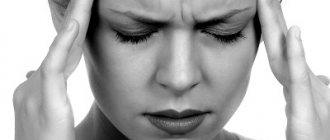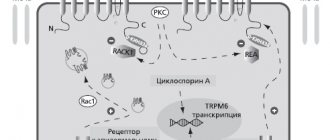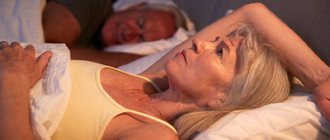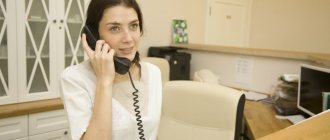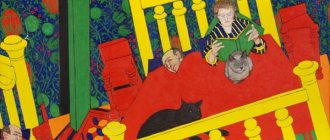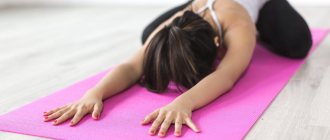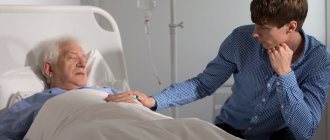27.01.2021
In old age, healthy sleep means a lot; an old person needs balanced rest, a comfortable sleeping place and a normal daily routine. However, as practice shows, many pensioners stay awake at night, suffer from insomnia or do not get enough sleep due to psychological disorders. The reasons for this condition can be varied - stress experienced the day before, pain that worsens at night, or specific diseases that should be treated by specialists.
Causes of sleep disorders in the elderly
At night, many older people experience a feeling of anxiety and restlessness, succumb to internal experiences, analyze their day, feel sorry for themselves, and remember their untimely departed friends and relatives. All this affects the quality of rest - old people fall asleep for a long time, often wake up and sometimes even walk at night, staying in the “kingdom of Morpheus”.
Insomnia can be caused by:
- incorrect daily routine - often retirement leads to the fact that a person stops following his usual schedule, goes to bed late and is in no hurry to get up in the morning;
- lack of physical activity - old people simply do not expend accumulated energy and do not have time to get tired;
- diseases accompanied by pain - chronic pain, neurological diseases, pathologies of the cardiovascular system prevent a pensioner from sleeping if they are not treated;
- depression – problems that accumulate like a lump, leading to chronic lack of sleep;
- long-term use of sleeping pills – long-term therapy with sedative medications does not make them effective, reduces their effectiveness and triggers the opposite effect;
- conditions that require improvement - unsuitable humidity, temperature, lighting, uncomfortable mattress, too warm or cold blanket, high pillow negatively affects the comfort of the sleeping person;
- life's troubles, stress, unpleasant events do not allow you to relax and fall asleep quickly;
- high blood pressure, snoring, tachycardia, poor cerebral circulation and other somatic diseases in people over 60 years of age negatively affect the quality of rest of an elderly patient;
- senile dementia, Parkinson's disease, Alzheimer's disease, etc.
It is difficult to fall asleep after a heavy dinner; insomnia often accompanies those who do not go to bed on an empty stomach. Contrary to the popular belief that alcohol accompanies relaxation, drinking alcohol excites the nervous system and interferes with proper rest in old age.
Dream from an oat field
The role of a sleeping pill can be performed by oat grains or oat flakes:
- Pour boiling water over a glass of oats and cook until it thickens, add a spoonful of honey and keep on fire for a few more minutes. Take half a glass 2-3 times a day.
- 1 tbsp. l. oat grains or flakes are boiled in 2 glasses of water. The decoction is drunk day and night.
- 2 tablespoons of grains are poured into a glass of boiling water. Leave it in this form overnight and cook it in a water bath for about half an hour in the morning. Use until evening.
USEFUL INFORMATION: How to overcome insomnia without medications and learn to fall asleep easily: practical tips
Symptoms of sleep disorders in the elderly
Therapy for insomnia is based on combating the symptoms of the disease, which requires careful diagnosis; drugs are selected based on an analysis of the general condition of the elderly patient. The disorder at a respectable age is manifested by the following symptoms:
- difficulties falling asleep, which you have to struggle with periodically;
- increased frequency of unpleasant dreams that make you wake up in a cold sweat with a feeling of fear, powerlessness, regret, accompanied by a rapid heartbeat;
- rest has become superficial, you often wake up at night, sleep lightly, are distracted by the slightest movement or rustle;
- waking up too early, inability to fall asleep again;
- You have to fight the signs of fatigue even after a full 8-hour rest.
Depending on the course of the disease and its symptoms, two types of insomnia are distinguished: transient - often caused by stress, recovery occurs on its own within 7-14 days; chronic – problems become regular, sleep disorders persist for more than 4 weeks; specific therapy is required to recover.
What causes insomnia in women
Women are more susceptible to insomnia than men: for example, women aged 40-60 years are twice as likely to be diagnosed with sleep disorders than men. However, perhaps women are simply more sensitive to their health and more often seek help from a neurologist or psychotherapist. Some of the most common causes of insomnia in women include:
- various hormonal changes during the menstrual cycle, pregnancy, breastfeeding and menopause;
- problems in personal life;
- conflict situations at work;
- long-term diet;
- abuse of caffeine-containing products (coffee, tea, chocolate, etc.);
- physical discomfort (uncomfortable mattress or pillow, heat in the room, extraneous noise).
In the absence of full sleep for three weeks or more, we can talk about the transition of insomnia to the chronic stage. Long-term sleep disturbances are dangerous to health; they can provoke disruptions in the immune system, somatic and mental illnesses, as well as the appearance of premature signs of aging.
Forms of manifestation of insomnia
Insomnia affects the quality of life, makes a person irritable, nervous, and leads to serious psychological disorders. It is customary to distinguish three forms of unhealthy condition:
- Insomnia. The pathology is characterized by the inability to fall asleep, even if you manage to forget yourself, the rest is short and restless. Usually the condition is caused by psychological stress; eliminating the root causes leads to normalization of the daily routine. A psychotherapist should treat such patients.
- Hypersomnia. Unlike insomnia, a patient suffering from hypersomnia needs a long rest - from 12 to 22 hours. Even after almost a day's stay in bed, the feeling of vigor does not occur, the patient is unable to regain strength, looks tired, suffers from nervous excitement, or, on the contrary, looks disoriented and confused. The disease is diagnosed in people living in conditions of constant stress.
- Parasomnia. Sleep disorders occur in separate phases; a person has to get out of bed several times a night, often in a sleepy state. The cause of the painful condition is epilepsy, sleepwalking, urinary incontinence, phobias, pain during erection in men.
Based on the diagnosed form, appropriate therapy is selected, which is designed to normalize the daily routine of the elderly patient.
Medicines from the garden
Regular dill improves sleep:
- Fill with two glasses of boiling water, 2 tsp. Dill seeds are kept for 10 minutes. For 2 days, take three times a day.
- 15–20 min. boil in dry red wine (50 g of dill seeds and 1/2 liter of wine), leave in a warm place for up to three hours. Daily dose: 1/4 glass before going to bed.
- Filled with two glasses of water 1 tbsp. l. dill is infused, after straining, drink a teaspoon at night.
Regular onions, which should be eaten immediately before bedtime, will help you fall asleep quickly.
Traditional methods of treatment
Unlike traditional medicines, “grandmother’s” methods have no contraindications or side effects, are accessible to everyone and do not require large financial expenditures. Elderly people often resort to well-known recipes from the people:
- Valerian root. An effective, safe plant that has a pronounced calming and sedative effect. In accordance with the instructions, you should take the tincture or tablets for several weeks, since the active substance has a cumulative effect. However, some reviews say that the drug immediately relieves symptoms and makes it possible to sleep well on the first night after taking it. To mask the specific taste of valerian, it is recommended to drink the tablet form or take a tincture with mint essence to give the drink a more pleasant taste.
- A glass of milk at night. Grandma's old method is an effective way to set the body up for rest. The effectiveness of the method lies in the amino acid tryptophan, which is part of milk. The component helps the brain launch processes that switch the body into sleep mode. If you are not a big fan of milk or don’t want to drink liquid before going to bed, try eating some legumes, white meat chicken, and cottage cheese for dinner.
- Chamomile tea. Chamomile decoction is widely used in the treatment of insomnia and improving psychological well-being throughout the world. To enhance the effect, you can add a few drops of essential chamomile oil to your evening bath to overcome frustration, relax and tune in to the right atmosphere. It is recommended to drink herbal tea no more than 3 times a day; if desired, you can add honey to the drink.
In addition to traditional desktop activities that require the presence of two or more participants, old people are often carried away by their computer counterparts. Based on the results of recent studies, retirees enjoy spending time on the computer, mastering social networks, popular computer applications and simulators. Particularly popular among old people are “adventure games”, toys for logic, quick reaction and simple strategies. In this case, the computer allows you to maintain mental health, develop intellectual abilities, and prevent the occurrence of diseases of the nervous system. You can download any application to your computer; you can find free versions or inexpensive computer games.
The following herbal components are designed to combat sleep disorders: lemon balm, mint, lemongrass, parsnip, lavender, oregano, creeping thyme, sage, hops, celery root and others. Aromatherapy relieves sleep disorders. Inhaling the aroma of lavender or rose promotes relaxation; just drop a few drops on your pillow, light an aroma lamp, or fill your bedroom with the scent of incense sticks. In addition, reading a book in bed, meditation, and even calling a friend or close relative will help restore your routine.
Possibilities for correcting insomnia (insomnia) without the use of sleeping pills
Insomnia is the most common sleep disorder. This is a clinical syndrome characterized by the presence of recurring complaints of any presomnic (prolonged falling asleep), intrasomnic (frequent awakenings during the night, after which it is difficult for the patient to fall back to sleep, a feeling of superficial and non-restorative sleep) and post-somnic disorders (early awakening, lack of cheerfulness, feeling of weakness) , arising provided there is sufficient time and an appropriate environment for sleep.
An important characteristic of insomnia is that disturbances in nighttime sleep affect daytime activities, causing fatigue, decreased concentration, decreased mood, drowsiness, muscle tension, headaches and gastrointestinal disturbances. The diagnosis of insomnia is made if the above-described sleep disorders are observed at least 3 times a week for at least 1 month [1].
Insomnia syndrome can develop both primarily, for specific reasons, and in the structure of mental and somatic diseases or drug abuse. In the latest International Classification of Sleep Disorders of 2005 (ICDS-2), 9 clinical and etiopathogenetic subtypes of insomnia are identified [3]. Of the independent (primary) forms of insomnia, the primary adaptation and psychophysiological ones have the greatest clinical significance.
Epidemiology
According to several large epidemiological studies, insomnia syndrome occurs in 4–6% of the general population [2], however, it should be borne in mind that the described symptoms and complaints lie in the subjective sphere of perception and are difficult for clinical assessment. Thus, without taking into account the frequency, duration and intensity, certain symptoms of insomnia can be detected in 48% of people [2].
In a 1991 study in the United States, 30–35% of respondents reported some kind of sleep disturbance over the past year, and 10% reported chronic and/or severe insomnia [4]. In Canada, 29.9% of 2000 respondents reported recurrent sleep disturbances, and in 9.5% the frequency and duration of these disturbances met the criteria for insomnia [5]. Similar results were obtained in a Swiss study conducted among adults of working age, 9% of whom had insomnia. In Great Britain for the period from 1993 to 2007. there is a gradual increase in the prevalence of insomnia from 3.1% to 5.8% and an increase in the number of patients with complaints of sleep disorders from 35.0% to 38.6% [6].
It is known that women suffer from insomnia 1.5 times more often than men [7], people over 75 years old - 2 times more often than in middle age [8].
Despite the fact that the symptoms of insomnia do not seem dangerous, and many patients habitually live with them for many years, this condition significantly reduces the quality of life, increases the risk of road traffic accidents (2.5–4.5 times) and work-related injuries (8 times) [2]. Daytime manifestations of insomnia, including daytime sleepiness, seriously affect performance, even if a person does not take a day off after a sleepless night. This phenomenon is called presenteeism (from the English present - to be present) - an employee is present at the workplace, but due to poor health, he works less efficiently than usual. A study of 10,000 employees of large American companies showed that the consequences of presenteeism are more likely to cause dismissals compared to absenteeism (absence from work due to illness) [9]. The annual loss of work time due to presenteeism due to insomnia averaged 11.3 days, and the monetary loss to companies associated with unsatisfactory performance of an employee's work duties was $2,280 per person, which exceeds the costs of insurance companies and damages to employers due to absenteeism.
Pathophysiology
Some theories of the development of insomnia suggest the presence of a common mechanism with degenerative diseases, the influence of insomnia on life expectancy [10]. At the same time, the comorbidity of insomnia with such syndromes as hypertension and metabolic syndrome has already been proven. The proposed mechanisms of this connection: dysfunction of the autonomic system, the release of somatotropic hormone, cortisol, activation of the sympathetic-adrenal system at night. The positive effect of insomnia treatment on daily blood pressure has been proven.
The presence of insomnia increases the risk of developing mental disorders (for example, depression by 4 times), alcoholism, and drug abuse. There is also an inverse relationship: symptoms of insomnia can develop against the background of a mental or physical illness, worsening the quality of life, response to drug therapy and the prognosis of the underlying disease.
Currently, there are several theories explaining the occurrence of insomnia: physiological, behavioral, cognitive and neurocognitive. The common key point of all models is hyperactivation of the body (hyperarousal), manifested at the neurophysiological, somatic, cognitive and emotional levels. It develops in predisposed patients and is manifested by the inability of somnogenic systems to suppress the activity of wakefulness systems and, consequently, increased sensitivity to external stimuli.
In the central nervous system, hyperactivation affects the limbic area, which in turn activates the cerebral cortex. The presence of hyperactivation at the neurophysiological level was confirmed as follows: positron emission tomography with the introduction of labeled glucose 18-F-FDG, carried out in people suffering from insomnia, showed that during sleep they do not experience the normal decrease in glucose metabolism in the brain, in in particular, in the ascending reticular formation and in the hypothalamus, insular cortex, amygdala, hippocampus, anterior cingulate and medial prefrontal cortex [11]. These same patients showed a decrease in metabolism in large areas of the bilateral frontal cortex, the upper parts of the left temporal, parietal and occipital cortex, and the thalamus during the day, which may serve as neurophysiological correlates of daytime symptoms of insomnia. The same authors showed a connection between activation indicators on the electroencephalogram (EEG) (high-frequency beta rhythm) and an increase in glucose metabolism in the ventromedial prefrontal cortex [12]. Data from these studies suggest that structures regulating emotional behavior, response to stimuli, and goal-directed behavior play an important role in generating and reinforcing hyperactivation in insomnia. Studies using functional magnetic resonance imaging have shown that relaxation techniques and cognitive behavioral therapy can correct these abnormalities in neuronal activity [13].
High levels of cortisol during the day also contribute to increasing the body’s readiness to respond to a stimulus. It still remains unclear what comes first: sleep fragmentation and frequent awakenings are stressors and cause an increase in cortisol or increased functioning of the hypothalamic-pituitary-adrenal system can cause hyperactivation of neuronal structures and symptoms of insomnia [14].
It has also been shown that insomnia sufferers, in contrast to people subjected to a single sleep deprivation, have higher rates of rectal temperature, heart rate, vasoconstriction and skeletal muscle contractions during wakefulness and sleep, as well as decreased tone of the parasympathetic nervous system and increased tone of the sympathetic nervous system. , which indicates changes in the systemic regulation of the body’s activity [14].
In the psycho-emotional sphere, hyperactivation is manifested by increased anxiety, neurotic reactions, and the use of maladaptive coping strategies, which can either be a background for the development of insomnia or appear simultaneously with it. It is not surprising that insomnia develops more often in women, the elderly, as well as among people suffering from mental or physical illnesses, in groups with low socioeconomic status and low levels of education.
Sleep disturbances in anxious, emotional people are accompanied by non-adaptive psychological self-regulation, which increases the activity of the above brain structures. In the cognitive domain, this hyperactivity manifests itself as intrusive thoughts and dysfunctional beliefs about sleep; in the sensitive area - difficulty in differentiating stimuli, increased perception of painful sensations, noise, the urge to urinate, which not only makes it difficult to fall asleep, but also reduces the threshold for awakening; in the emotional sphere - fear of insomnia and its consequences, dysphoria, depression [1].
A natural question arises about what comes first: hyperactivation or sleep disturbances. In search of an answer, studies were conducted in which the sleep pattern of insomnia sufferers was imitated in normal sleepers: taking caffeine-containing medications before bed, limiting sleep time to 4-6 hours, waking up at night. At the end of the experiment, the condition of the experimental subjects was assessed, which showed that their anxiety level increased significantly, daytime symptoms of insomnia appeared (fatigue, daytime sleepiness), and the EEG pattern of night sleep corresponded to the picture of insomnia. At the same time, changes in physiological indicators (body temperature, heart rate) corresponded rather to indicators characteristic of long-term sleep deprivation [15]. Such results may indicate the presence of hyperactivation, which predisposes to the development of insomnia, and the existence of secondary symptoms that appear along with sleep disturbances.
Popular models of the development of insomnia include the identification of three groups of causal factors: predisposing, provoking and supporting (three “Ps”). Predisposing factors include biological (regular increases in cortisol levels, increased heart rate, impaired sympathetic-parasympathetic relationships), psychological (high anxiety), social (shift work, childbirth, low socioeconomic level, low level of education) and behavioral (poor hygiene sleep) [2]. This group also includes heredity, the role of which in the genesis of insomnia is still being studied. Thus, in 2005, the presence of a hereditary predisposition to insufficiency of somnogenic systems in Drosophila fruit flies was proven [6]. Population studies in humans have also been able to confirm the familial nature of insomnia [1].
At the onset of insomnia, provoking factors appear, which can be any stressful event. If the psychological and neurophysiological compensatory systems of the body are preserved, after the end of the stressogen, symptoms regress. However, the presence of predisposing factors leads to chronicity of insomnia after the trigger is eliminated due to the development of supporting factors—the use of inadequate coping strategies (behavioral methods of overcoming the problem) [2].
Methods of therapy. Pharmacotherapy
Taking into account the presence of a complex multifactorial genesis of any form of insomnia, realized at various levels, the need for an integrated approach, including the use of psycho- and pharmacotherapeutic methods of correction, becomes obvious. Psychotherapeutic methods become especially relevant in cases of chronic insomnia, accompanied by anxiety and depressive disorders, when emotional and behavioral aspects require more attention, while pharmacological agents are given an auxiliary role. However, the practical application of these techniques is complicated by the need for regular consultations with a specialist, constant adherence to a number of rules, performing relaxation exercises, and the complexity of implementing methods such as limiting sleep time often makes it impossible for patients, especially in the presence of concomitant diseases and low adherence to treatment , dysfunctional ideas about insomnia. Often, it is easier for doctors in clinics and hospitals to prescribe sleeping pills instead of starting long-term and labor-intensive behavioral therapy. However, in some situations, the use of pharmacotherapy is justified as a supporting component at the beginning of the treatment of chronic insomnia using cognitive-behavioral methods or as monotherapy (for adaptive insomnia or for diseases concomitant with insomnia).
Sleeping pills are a diverse group of psychoactive drugs used to facilitate sleep onset and ensure sufficient duration of sleep. Most hypnotics exert their effect through their effect on the postsynaptic GABAergic complex: barbiturates, benzodiazepines, cyclopyrrolones and others. In addition, some neuroleptics, antidepressants, anticonvulsants, and antihistamines have a hypnotic and sedative effect. When choosing a sleeping pill, you should focus on the speed of onset of action, short half-life, absence of side effects, addiction and withdrawal syndrome, the possibility of correcting other diseases (for example, for depression or a neurotic disorder, preference is given to antipsychotics and antidepressants with a sedative effect, for pain syndrome - anticonvulsants) . Many drugs have a hypnotic and sedative effect, including those not specifically used as sleeping pills - this must be taken into account when managing patients already receiving treatment for other diseases.
The drugs of choice for the treatment of insomnia are non-benzodiazepine GABA receptor agonists, the so-called Z-drugs: zopiclone (Relaxone, Somnol), zolpidem (Hypnogen, Zonadin, Sanval) and zaleplon (Andante). Benzodiazepines, which were widely used as hypnotics before the discovery of Z-drugs, are now fading into the background due to the high incidence of unwanted side effects such as daytime sleepiness and decreased concentration, which have time to develop due to a long half-life. In addition, when taking both benzodiazepines and barbiturates, addiction, abuse and withdrawal symptoms may develop.
Cognitive behavioral therapy for insomnia
Cognitive behavioral therapy is aimed at eliminating the provoking and supporting factors of insomnia (behavioural, cognitive and psychological): non-compliance with sleep patterns and habits, hyperactivation and anxiety, dysfunctional ideas about sleep. It includes several non-drug methods for treating insomnia: sleep hygiene, relaxation techniques, stimulation control, sleep restriction.
Sleep hygiene. Sleep hygiene education covers education about lifestyle (diet, physical activity, bad habits) and the environment (lighting, noise, temperature) that can improve or disrupt sleep. The rules also include general recommendations for improving sleep quality:
- maintaining a sleep-wake schedule: going to bed and getting up at the same time;
- limiting the amount of mental and physical activity an hour before going to bed;
- avoiding the use of stimulants and sleep-disrupting drugs (caffeine, cola, alcohol, nicotine) several hours before bedtime;
- adherence to a diet (do not overeat, but do not go to bed hungry);
- comfortable conditions in the bedroom/sleeping area: minimal level of illumination, noise/white noise, moderate air temperature, comfortable mattress, pillow, bedding, sleepwear;
- the bed is intended only for sleeping, and any physical or mental activity (except sexual) is prohibited in it.
Although poor adherence is rarely the primary cause of insomnia, it can worsen sleep problems caused by other causes or interfere with treatment. Even if the patient is aware of the consequences of poor sleep hygiene, he is not always ready to adhere to them, so the importance of adherence to these measures must be emphasized at each consultation. Assessing compliance with the rules is possible using a sleep diary, where, along with the time of going to bed and getting up, the patient can note physical activity, alcohol intake, and medications. To more accurately assess compliance with the rules, special questionnaires have been developed: Sleep Hygiene Index, Sleep Hygiene Awareness and Practice Scale [16].
According to meta-analyses comparing the effectiveness of different behavioral techniques as monotherapy, sleep hygiene has the least effectiveness compared to stimulation control, sleep restriction and relaxation techniques [17, 18]. Also, adherence to sleep hygiene measures is ineffective as monotherapy for long-term and severe chronic insomnia, so it is more rational to use it in combination with other methods. At the same time, patients rate this method as the most preferable, along with relaxation techniques. This is likely due to the fact that its mechanism of action is clear and acceptable to patients, as opposed to stimulation control and sleep restriction.
Limiting sleep time. Patients who have difficulty falling asleep tend to increase the time spent in bed, believing that quantity becomes quality. In fact, the opposite situation arises: even if they manage to increase the duration of sleep, it becomes superficial, easily interrupted by minor stimuli - due to this, the quality and satisfaction of sleep deteriorates. It is precisely this behavioral factor that is influenced by the sleep restriction technique: the time spent in bed is artificially reduced to the time that the patient, in his opinion, actually sleeps; then, as the required sleep efficiency is achieved, he is allowed to increase the time in bed. The time of going to bed, waking up and sleep efficiency are recorded daily in a diary. The severity of the technique may vary depending on adherence to treatment, the patient’s health status, and the rate of sleep improvement. For example, if the patient believes that out of 9 hours spent in bed he sleeps only 5, he is allowed to spend 5 hours in bed, excluding daytime sleep. If the patient notes that within a week (with a more gentle approach, 5 days or 3 days) of this regimen, sleep efficiency reaches 85% per night, he is allowed to shift his bedtime to 15–20 minutes earlier, or his wake-up time to the same time later, or split that time between going to bed earlier and waking up later.
The sleep restriction method is based on two mechanisms: due to mild sleep deprivation, “sleep pressure” increases by bedtime; the anxiety of waiting to fall asleep is reduced by shifting the hours allotted for sleep to a later time (for example, instead of going to bed at 00:00 and getting up at 5:00, the patient is asked to go to bed at 2:00 and get up at 7:00) [2]. The goal is to gradually increase sleep time to the maximum effective level, which is recommended after the end of treatment.
To avoid the development of severe daytime sleepiness, it is not recommended to reduce sleep time by less than 5 hours. The sleep restriction technique is contraindicated for use in patients with a history of seizures, parasomnias, or bipolar disorder, since sleep deprivation lowers the seizure threshold and can provoke an episode of sleepwalking or a manic phase. The method is used with caution in patients employed in hazardous work or driving transport, due to a possible increase in daytime sleepiness.
Stimulation control. The stimulation control method aims to restore the normal association between the bedroom/bed and sleep. Violation of this association occurs when the patient spends a long time in bed in anxious anticipation of sleep and fear of insomnia and its consequences tomorrow. Thus, the bedroom or bed, which a person usually associates with relaxation and sleep, begins to cause anxiety and restlessness in itself. In such cases, patients may report that in an unfamiliar place (at a party, on a train, in a sleep laboratory) they fall asleep better and faster than at home. This also includes sleep hygiene disorders that are common among people with insomnia, such as reading, working, watching movies, and eating in bed. The method includes a number of provisions:
- go to bed only when you feel sleepy (and not just tired);
- do not stay in bed if sleep does not occur (more than 20 minutes). In this case, it is recommended to go to another room, do quiet things and return to bed only when drowsiness appears;
- exclude any activity in bed that is not related to sleep (or sex): eating, watching movies and TV shows, working, as well as planning daytime activities and solving problems;
- get up at a set time, regardless of the need to go to work or the time of falling asleep the night before;
- eliminate daytime naps.
Methods of controlling stimulation and limiting sleep time may seem simple to implement at first glance, but daily implementation of these rules and regularly recording the results in a diary requires high discipline and adherence to treatment from the patient. The doctor’s task is constant support and motivation to strictly follow the rules, explaining the mechanisms of action of these techniques, since they may seem illogical to patients. When combining methods of stimulation control and limiting sleep time, contradictions may arise in the early stages: the patient should go to bed only when drowsiness appears, despite the fact that the time allotted for sleep is significantly limited. In this regard, at the beginning of treatment, emphasis should be placed on one of the methods, and as sleep time increases and a regular sleep/wake cycle is restored, these contradictions disappear. Prohibiting daytime naps can also cause strong opposition to the methods. A short nap during the day is acceptable in the first stages of treatment when working with the elderly (due to the risk of injury due to severe drowsiness) or in order to increase patient adherence to treatment.
Relaxation techniques. Relaxation techniques are effective for insomnia because sleep disturbances are most often accompanied by tension, stress and anxiety. Techniques can be aimed at somatic (progressive muscle relaxation, autogenic training) or psycho-emotional and cognitive hyperactivation (attention training: imagery training, meditation, stopping the mental flow, conscious thinking), depending on the predominant type. Biofeedback using electromyography or EEG is considered highly effective, when the patient learns to relax muscles or achieve alpha rhythm on the EEG, observing the results of his attempts on the screen. It should be emphasized that the goal of this approach is to reduce tension and hyperactivation, and not to speed up sleep. Patients prone to perfectionism may experience a paradoxical response to treatment when, in an effort to achieve a better result, their anxiety and tension increase. Classes using one or another method should be held daily under the supervision of a specialist, at least in the first stages, and for 2–4 weeks.
Cognitive therapy. Patients with insomnia tend to catastrophize their illness; they believe that the later they fall asleep, the less energy they will have and the worse the next day will be, and this increases anxiety and tension; that in order to get enough sleep they need to sleep for a certain amount of time, for example 8 hours, and in their attempts to sleep they often check the clock to see how much time they have left; associate insomnia with the presence of dangerous diseases or consider it a serious health hazard. The goal of cognitive therapy is dysfunctional beliefs about sleep and maladaptive behavioral strategies; its methods are behavioral experiments and Socratic dialogue, when the patient is asked consistent questions, answering which he independently formulates the correct judgments. The main ideas of this technique are:
- form realistic ideas about the body’s need for sleep and sources of daytime energy;
- stop “blaming” insomnia for your daytime failures - there may be other objective reasons for this;
- do not try to fall asleep, because such tactics are associated with hyperactivation, which prevents falling asleep;
- do not attach central importance to sleep in life and do not catastrophize the causes and consequences of sleep disorders;
- be prepared that after achieving remission of insomnia, provoking situations may lead to a resumption of symptoms. That is, the sleep hygiene regime and rules formed during treatment should be adhered to throughout life.
Patients with persistent dysfunctional beliefs are asked to conduct experiments in which such beliefs are not confirmed. For example, if a patient believes that the more time he spends in bed, the better rested he will be, he is encouraged to follow this strategy after a night of insomnia. After the next sleepless night, a number of other methods of restoring energy are offered for comparison: physical exercise, meeting with friends, creative activities.
Recommendations for establishing a special time for solving problems and planning activities for the next day, a week a few hours before bedtime may be useful; change of sleep environment.
If classical methods are ineffective, paradoxical psychotherapy is used, when the patient is given advice that directly contradicts common sense: for example, try not to fall asleep no matter what (the method of paradoxical intention).
The choice of cognitive behavioral therapy techniques should be made individually, taking into account the main causes and manifestations of hyperactivation, but this requires a lot of time. The solution may be to conduct group sessions with 7–10 patients; in this case, creating an environment of people with similar problems has an additional positive effect for each participant in the form of social support and a sense of the importance of the problem. With limited appointment time, and also in order to consolidate the information received by the patient during the consultation, it is worth paying attention to bibliotherapy - the use of printed or video materials describing the methods of cognitive behavioral therapy - with a responsible approach and the right recommendations, the patient can independently achieve improved night sleep; The effectiveness of this approach has been proven in a number of studies [19, 20].
Special mention should be made of melatonin preparations, a hormone produced by the human pineal gland and having chronobiological, mild somnogenic, antioxidant and a number of other important properties. Thus, one of the melatonin preparations available in Russia, Melaxen, is characterized by a wide therapeutic spectrum, the absence of side effects, potential addiction and withdrawal syndrome. Despite the fact that the drugs are not considered hypnotics, they can be used as the main or auxiliary means for any form of insomnia [21]. Melaxen is used in a dose of 3 mg one hour before expected bedtime. The drug is sold in pharmacies without a doctor's prescription.
Thus, we can conclude that in the treatment of various types of insomnia, there are two main approaches: pharmacotherapeutic and cognitive-behavioral, each of which has several options of action that are different in effectiveness and focus. Each specific case of insomnia requires individual selection of pharmaco- or cognitive-behavioral therapy or a combination of both. The form of insomnia, the patient's health status, his adherence to therapy and preferences play an important role. It should be emphasized that in some forms of insomnia, drug therapy is not indicated (paradoxical insomnia). At the same time, cognitive behavioral therapy, which affects the predisposing and supporting mechanisms of insomnia, is a pathogenetically substantiated method of choice for any form of insomnia and has no direct contraindications. 67–82% of patients give their preference to cognitive-behavioral techniques, which has been confirmed in a number of surveys [22, 23].
Literature
- Poluektov M. G., Levin Ya. I. (eds.). Somnology and sleep medicine. M.: Medforum; 2013, 432 p.
- Kryger MH, Roth T., Dement WC (eds) Principles and practice of sleep medicine 5 th ed. St. Louis, Missouri: Elsevier Saunders, 2011.
- International Classification of Diseases, 10th Revision (ICD-10). Geneva: World Health Organization; 1992.
- Ohayon MM Epidemiology of insomnia: what we know and what we still need to learn // Sleep Med Rev. 2002; 6(2):97–111.
- Morin CM, LeBlanc M., Daley M., Gregoire JP, Mérette C. Epidemiology of insomnia: prevalence, self-help treatments, consultations, and determinants of help-seeking behaviors // Sleep Med. 2006; 7 (2): 123–130.
- Calem M., Bisla J., Begum A., Dewey M., Bebbington P.E., Brugha T. et al. Increased prevalence of insomnia and changes in hypnotics use in England over 15 years: analysis of the 1993, 2000, and 2007 National Psychiatric Morbidity Surveys // Sleep. 2012; 35(3):377–384.
- Kravitz HM, Ganz PA, Bromberger J., Powell LH, Sutton-Tyrrell K., Meyer PM Sleep difficulty in women at midlife: a community survey of sleep and the menopausal transition // Menopause. 2003; 10 (1): 19–28.
- Monane M. Insomnia in the elderly // J Clin Psychiatry. 1992; 53 Suppl: 23–28.
- Kessler RC, Berglund P. A. et al. Insomnia and the performance of US workers: results from the America insomnia survey // Sleep. 2011; 34(9):1161–1171.
- Kripke DF, Garfinkel L, Wingard DL et al. Mortality associated with sleep duration and insomnia // Arch. Gen. Psychiatry. 2002; 59: 131–136.
- Nofzinger EA, Buysse DJ, Germain A. et al. Functional neuroimaging evidence for hyperarousal in insomnia // Am J Psychiatry. 2004; 161:2126–2131.
- Nofzinger EA, Price JC, Meltzer CC et al. Towards a neurobiology of dysfunctional arousal in depression: the relationship between beta EEG power and regional cerebral glucose metabolism during NREM sleep // Psychiatry Res. 2000; 98: 71–91.
- Lou HC, Kjaer TW, Friberg L. et al. A 15O-H2O PET study of meditation and the resting state of normal consciousness // Hum Brain Map. 1999; 7:98–105.
- Basta M., Chrousos G.P., Vela-Bueno A. et al. Chronic insomnia and stress system // Sleep Med Clin. 2007; 2: 279–291.
- Bonnet MH, Arand DL Hyperarousal and insomnia: state of the science // Sleep Med Rev. 2010; 14:9–15.
- Mastin DF, Bryson J., Corwyn R. Assessment of sleep hygiene using the Sleep Hygiene Index // J Behav Med. 2006; 29(3):223–227.
- Morin CM, Culbert JP, Schwartz SM Nonpharmacological interventions for insomnia: a meta-analysis of treatment efficacy // Am J Psychiatry. 1994; 151:1172–1180.
- Murtagh DR, Greenwood KM Identifying effective psychological treatments for insomnia: a meta-analysis // J Consult Clin Psychol. 1995; 63:79–89.
- Riedel BW, Lichstein KL, Dwyer WO Sleep compression and sleep education for older insomniacs: self-help versus therapist guidance // Psychol Aging. 1995; 10:54–63.
- Mimeault V., Morin CM Self-help treatment for insomnia: bibliotherapy with and without professional guidance // J Consult Clin Psychol. 1999; 67:511–519.
- Poluektov M. G., Levin Ya. I. Results of a Russian multicenter open observational non-comparative study of the effectiveness and safety of the drug Melaxen (melatonin) for the treatment of sleep disorders in patients with chronic cerebral vascular insufficiency // Journal of Neurology and Psychiatry named after. S. S. Korsakova. 2012; 9:26–31.
- Morin C., Gaulier B., Barry T., Kowatch R. Patients' acceptance of psychological and pharmacological therapies for insomnia // Sleep. 1992; 15: 302–305.
- Vincent N., Lionberg C. Treatment preference and patient satisfaction in chronic insomnia // Sleep. 2001; 24 (4): 411–417.
M. G. Poluektov1, Candidate of Medical Sciences P. V. Pchelina
GBOU VPO First Moscow State Medical University named after. I. M. Sechenova Ministry of Health of the Russian Federation, Moscow
1 Contact information
Choosing the right insomnia remedy for an elderly person
There are medications whose action is aimed at correcting such disorders; they should be taken only with a prescription and the recommendation of a doctor. If a person suffers from insomnia, cannot fall asleep on his own, suffers from nightmares, or does not get enough sleep even after a long rest, the doctor prescribes adaptogens containing melatonin to patients.
To combat the symptoms of senile insomnia, you will need to take medications with a pronounced anti-anxiety effect. If an elderly person suffers from individual intolerance or one of the components causes an allergic reaction, the doctor prescribes non-benzodiazepine benzodiazepine receptor agonists, which do not affect the respiratory system and are not prone to accumulation. Psychotherapists often prescribe herbal remedies for older people to normalize rest and wakefulness: “Persen”, “Sedasen”, “Novo-Passit”, “Motherwort”, etc.
Combination drugs containing phenobarbital have a good effect for treating insomnia in pensioners. A group of medications is recommended to be taken for insomnia in particularly severe cases, accompanied by increased nervous excitability. Long-term use of these medications is fraught with addiction, negatively affects the general condition, and aggravates problems with falling asleep.
Medicines with nootropic effects - “Glycised”, “Glycine” - are good for senile insomnia. Effective remedies for insomnia normalize brain function and relieve irritability. It is strictly forbidden to combine the use of sleeping pills with alcohol and antihistamines. Carelessness can lead to urination problems, headaches, tachycardia and more serious side effects.
How to fall asleep quickly if you have insomnia
Scientists believe that healthy sleep is a reflex mechanism. If a person goes to bed and does not fall asleep after 15-20 minutes, you should not lie in it any longer. Otherwise, this will lead to the formation of a new reflex: bed-insomnia.
You can independently fight acute insomnia that has arisen for the first time. First you need to get rid of the factors that interfere with sleep. To do this, you need to turn off the TV or computer monitor, curtain the windows if the light of lanterns or the moon shines through the window.
It is bad to fall asleep in a stuffy and hot room. Therefore, if the question arises of how to fall asleep with insomnia, you need to open the window for ventilation and reduce the heat supply to the heating radiators. During this time, you can go for a leisurely walk in the fresh air. After returning home, drink a glass of warm milk or herbal tea. This is an old method that has proven effective for mild disorders.
Milk contains substances that help produce melatonin. This is a pineal gland hormone that regulates circadian rhythms, changes in sleep and wakefulness, and controls the functioning of the immune and endocrine systems. Therefore, insomnia increases the risk of infectious diseases and metabolic disorders, problems in the male reproductive system.
Reading helps you fall asleep quickly. But for this you need to choose not an exciting detective story, but literature of a calm nature, which usually causes drowsiness. If these methods do not help you fall asleep, the disturbances persist and bother you regularly, an examination and consultation with a doctor is necessary.
Insomnia pills
Only a doctor can advise you on a suitable drug for insomnia. When selecting a medicine, a specialist will carefully understand the causes of sleep disturbances, conduct the necessary diagnostic tests and analyzes and only after that will prescribe the necessary remedy that will show maximum effectiveness with minimal harm to health. The doctor will be able to take into account all important factors: the individual characteristics of your body, age, specialty and concomitant pathology.
Now let's talk about medications against insomnia, which can be purchased at a pharmacy without a doctor's prescription.
Persen
This herbal preparation includes mint, lemon balm and valerian. It has a mild sedative and hypnotic effect. Persen will help in the fight against mild insomnia caused by emotional stress. For insomnia, you need to take 3 tablets 1 hour before bedtime. The maximum effect can be achieved with a course of treatment.
Glycine
Glycine is an amino acid that is actively involved in the regulation of the central nervous system. It affects special brain receptors, causing inhibition and slowing down the transmission of nerve impulses. It is a sedative that helps cope with insomnia caused by mental and emotional fatigue. To achieve a “soporific” effect, tablets should be taken in a dosage of 100 mg sublingually (under the tongue) half an hour before bedtime for 1-2 months.

